Computationally Efficient Models of High Pressure Rolling for Wire Arc Additively Manufactured Components
Abstract
1. Introduction
1.1. Non-Uniform Mesh Density
1.2. Reduced Length of Modelled Component
1.3. Rigid Roller
1.4. 2D Rolling Model
1.5. Explicit Analysis for Contact Problems in Rolling
1.6. Eulerian Analysis for Contact Problems in Rolling
2. Material and Methods
2.1. Large Scale Implicit Transient Load-Controlled Model
2.2. Short Implicit Transient Displacement-Controlled Model
2.3. Short Explicit Trasient Displacement-Controlled Model
2.4. Eulerian Steady-State Model
2.5. 2D Short Implicit Transient Displacement-Controlled Model
2.6. Inspection Planes for Comparison between Different Models
3. Results
3.1. Computational Efficiency
3.2. Steady-State Rolling
3.3. Solution Accuracy
2D vs. 3D Rolling Models
4. Discussion
4.1. Computational Efficiency
4.2. Steady-State Rolling and Its Implicaiton in Computational Efficiency
4.3. Solution Accuracy
4.4. Rolling Model with WAAM Deposition RS
5. Conclusions
- The efficiency of a rolling model depends largely on the number of elements (or degrees of freedom) involved in the FEM analysis. Reduction of component length in the model can dramatically improve the computational efficiency without impairing solution accuracy, since steady-state rolling can be established within a region of short length.
- The implicit analysis method is more accurate and efficient than the explicit analysis method for the short rolling models with analytic rigid rollers and relatively low rolling loads.
- The solution of the 3D short implicit transient model is most accurate among the developed efficient models, as compared to the control model. The accuracy of the 3D short explicit transient model was impaired by the artificially assigned high density of material (mass scaling for acceleration of computation). Reduction of the mass scaling factor improved accuracy, but increased computational cost significantly. The 3D Eulerian steady-state model is less accurate due to unrealistic representation of the rolling process, and its efficiency is limited by the restriction that parallel computation is not supported when the steady-state detection feature is enabled using the employed version of Abaqus software.
- The 2D implicit transient model cannot capture the 3D deformation mechanism during rolling, and hence it is least accurate in predicting the distributions of longitudinal residual stress and plastic strain. Nevertheless, the 2D transient model is much more efficient than the 3D models, and it could be used for a quick qualitative estimate of the mechanical response of the WAAM component to rolling.
- Application of an elastic deformable roller instead of an analytic rigid roller in the 2D rolling model barely affected the solution, but significantly reduced computational efficiency.
Author Contributions
Funding
Institutional Review Board Statement
Informed Consent Statement
Data Availability Statement
Acknowledgments
Conflicts of Interest
References
- Karayel, E.; Bozkurt, Y. Additive Manufacturing Method and Different Welding Applications. J. Mater. Res. Technol. 2020, 9, 11424–11438. [Google Scholar] [CrossRef]
- Yilmaz, O.; Ugla, A.A. Microstructure Characterization of SS308LSi Components Manufactured by GTAW-Based Additive Manufacturing: Shaped Metal Deposition Using Pulsed Current Arc. Int. J. Adv. Manuf. Technol. 2017, 89, 13–25. [Google Scholar] [CrossRef]
- Colegrove, P.A.; Coules, H.E.; Fairman, J.; Martina, F.; Kashoob, T.; Mamash, H.; Cozzolino, L.D. Microstructure and Residual Stress Improvement in Wire and Arc Additively Manufactured Parts through High-Pressure Rolling. J. Mater. Process. Technol. 2013, 213, 1782–1791. [Google Scholar] [CrossRef]
- Martina, F.; Roy, M.J.; Szost, B.A.; Terzi, S.; Colegrove, P.A.; Williams, S.W.; Withers, P.J.; Meyer, J.; Hofmann, M. Residual Stress of As-Deposited and Rolled Wire+arc Additive Manufacturing Ti–6Al–4V Components. Mater. Sci. Technol. 2016, 32, 1439–1448. [Google Scholar] [CrossRef]
- Asala, G.; Khan, A.K.; Andersson, J.; Ojo, O.A. Microstructural Analyses of ATI 718Plus® Produced by Wire-ARC Additive Manufacturing Process. Metall. Mat. Trans. A 2017, 48, 4211–4228. [Google Scholar] [CrossRef]
- Gu, J.; Ding, J.; Williams, S.W.; Gu, H.; Ma, P.; Zhai, Y. The Effect of Inter-Layer Cold Working and Post-Deposition Heat Treatment on Porosity in Additively Manufactured Aluminum Alloys. J. Mater. Process. Technol. 2016, 230, 26–34. [Google Scholar] [CrossRef]
- Marinelli, G.; Martina, F.; Ganguly, S.; Williams, S. Microstructure, Hardness and Mechanical Properties of Two Different Unalloyed Tantalum Wires Deposited via Wire + Arc Additive Manufacture. Int. J. Refract. Met. Hard Mater. 2019, 83, 104974. [Google Scholar] [CrossRef]
- Marinelli, G.; Martina, F.; Ganguly, S.; Williams, S. Grain Refinement in an Unalloyed Tantalum Structure by Combining Wire+Arc Additive Manufacturing and Vertical Cold Rolling. Addit. Manuf. 2020, 32, 101009. [Google Scholar] [CrossRef]
- Marinelli, G.; Martina, F.; Lewtas, H.; Hancock, D.; Mehraban, S.; Lavery, N.; Ganguly, S.; Williams, S. Microstructure and Thermal Properties of Unalloyed Tungsten Deposited by Wire + Arc Additive Manufacture. J. Nucl. Mater. 2019, 522, 45–53. [Google Scholar] [CrossRef]
- Marinelli, G.; Martina, F.; Ganguly, S.; Williams, S. Development of Wire + Arc Additive Manufacture for the Production of Large-Scale Unalloyed Tungsten Components. Int. J. Refract. Met. Hard Mater. 2019, 82, 329–335. [Google Scholar] [CrossRef]
- Welding Engineering and Laser Processing Centre of Cranfield University. Demo Parts Built for Industry Partners. Available online: https://waammat.com/about/demo-parts (accessed on 15 December 2020).
- Williams, S.W.; Martina, F.; Addison, A.C.; Ding, J.; Pardal, G.; Colegrove, P. Wire + Arc Additive Manufacturing. Mater. Sci. Technol. 2016, 32, 641–647. [Google Scholar] [CrossRef]
- Lockett, H.; Ding, J.; Williams, S.; Martina, F. Design for Wire + Arc Additive Manufacture: Design Rules and Build Orientation Selection. J. Eng. Des. 2017, 28, 568–598. [Google Scholar] [CrossRef]
- Baufeld, B.; Van der Biest, O.; Gault, R. Additive Manufacturing of Ti–6Al–4V Components by Shaped Metal Deposition: Microstructure and Mechanical Properties. Mater. Des. 2010, 31, S106–S111. [Google Scholar] [CrossRef]
- Clark, D.; Bache, M.R.; Whittaker, M.T. Shaped Metal Deposition of a Nickel Alloy for Aero Engine Applications. J. Mater. Process. Technol. 2008, 203, 439–448. [Google Scholar] [CrossRef]
- Wu, B.; Pan, Z.; Ding, D.; Cuiuri, D.; Li, H.; Xu, J.; Norrish, J. A Review of the Wire Arc Additive Manufacturing of Metals: Properties, Defects and Quality Improvement. J. Manuf. Process. 2018, 35, 127–139. [Google Scholar] [CrossRef]
- Ding, J.; Colegrove, P.; Mehnen, J.; Williams, S.; Wang, F.; Almeida, P.S. A Computationally Efficient Finite Element Model of Wire and Arc Additive Manufacture. Int. J. Adv. Manuf. Technol. 2014, 227–236. [Google Scholar] [CrossRef]
- Ding, J.; Colegrove, P.; Mehnen, J.; Ganguly, S.; Sequeira Almeida, P.M.; Wang, F.; Williams, S. Thermo-Mechanical Analysis of Wire and Arc Additive Layer Manufacturing Process on Large Multi-Layer Parts. Comput. Mater. Sci. 2011. [Google Scholar] [CrossRef]
- Szost, B.A.; Terzi, S.; Martina, F.; Boisselier, D.; Prytuliak, A.; Pirling, T.; Hofmann, M.; Jarvis, D.J. A Comparative Study of Additive Manufacturing Techniques: Residual Stress and Microstructural Analysis of CLAD and WAAM Printed Ti–6Al–4V Components. Mater. Des. 2016, 89, 559–567. [Google Scholar] [CrossRef]
- Cordiano, H.V. Effect of Residual Stresses on the Low Cycle Fatigue Life of Large Scale Weldments in High Strength Steel. J. Eng. Ind. 1970, 92, 86–92. [Google Scholar] [CrossRef]
- Webster, G.A.; Ezeilo, A.N. Residual Stress Distributions and Their Influence on Fatigue Lifetimes. Int. J. Fatigue 2001, 23, 375–383. [Google Scholar] [CrossRef]
- Dong, P.; Brust, F.W. Welding Residual Stresses and Effects on Fracture in Pressure Vessel and Piping Components: A Millennium Review and Beyond. J. Press. Vessel. Technol. 2000, 122, 329–338. [Google Scholar] [CrossRef]
- Dong, P. Residual Stresses and Distortions in Welded Structures: A Perspective for Engineering Applications. Sci. Technol. Weld. Join. 2005, 10, 389–398. [Google Scholar] [CrossRef]
- Colegrove, P.A.; Martina, F.; Roy, M.J.; Szost, B.A.; Terzi, S.; Williams, S.W.; Withers, P.J.; Jarvis, D. High Pressure Interpass Rolling of Wire + Arc Additively Manufactured Titanium Components. AMR 2014, 996, 694–700. [Google Scholar] [CrossRef]
- McAndrew, A.R.; Alvarez Rosales, M.; Colegrove, P.A.; Hönnige, J.R.; Ho, A.; Fayolle, R.; Eyitayo, K.; Stan, I.; Sukrongpang, P.; Crochemore, A.; et al. Interpass Rolling of Ti-6Al-4V Wire + Arc Additively Manufactured Features for Microstructural Refinement. Addit. Manuf. 2018, 21, 340–349. [Google Scholar] [CrossRef]
- Hönnige, J.R.; Colegrove, P.A.; Ahmad, B.; Fitzpatrick, M.E.; Ganguly, S.; Lee, T.L.; Williams, S.W. Residual Stress and Texture Control in Ti-6Al-4V Wire + Arc Additively Manufactured Intersections by Stress Relief and Rolling. Mater. Des. 2018, 150, 193–205. [Google Scholar] [CrossRef]
- Martina, F. Investigation of Methods to Manipulate Geometry, Microstructure and Mechanical Properties in Titanium Large Scale Wire + Arc Additive Manufacturing; Cranfield University: Cranfield, UK, 2014. [Google Scholar]
- Colegrove, P.A.; Donoghue, J.; Martina, F.; Gu, J.; Prangnell, P.; Hönnige, J. Application of Bulk Deformation Methods for Microstructural and Material Property Improvement and Residual Stress and Distortion Control in Additively Manufactured Components. Scr. Mater. 2017, 135, 111–118. [Google Scholar] [CrossRef]
- Martina, F.; Colegrove, P.A.; Williams, S.W.; Meyer, J. Microstructure of Interpass Rolled Wire + Arc Additive Manufacturing Ti-6Al-4V Components. Metall. Mat. Trans. A 2015, 46, 6103–6118. [Google Scholar] [CrossRef]
- Hönnige, J.R.; Colegrove, P.A.; Ganguly, S.; Eimer, E.; Kabra, S.; Williams, S. Control of Residual Stress and Distortion in Aluminium Wire + Arc Additive Manufacture with Rolling. Addit. Manuf. 2018, 22, 775–783. [Google Scholar] [CrossRef]
- Lee, C.H.; Kobayashi, S. New Solutions to Rigid-Plastic Deformation Problems Using a Matrix Method. J. Eng. Ind. 1973, 95, 865–873. [Google Scholar] [CrossRef]
- Hwang, S.M.; Kobayashi, S. Preform Design in Plane-Strain Rolling by the Finite-Element Method. Int. J. Mach. Tool Des. Res. 1984, 24, 253–266. [Google Scholar] [CrossRef]
- Cozzolino, L.D.; Coules, H.E.; Colegrove, P.A.; Wen, S. Investigation of Post-Weld Rolling Methods to Reduce Residual Stress and Distortion. J. Mater. Process. Technol. 2017, 247, 243–256. [Google Scholar] [CrossRef]
- Abbaszadeh, M.; Hönnige, J.R.; Martina, F.; Neto, L.; Kashaev, N.; Colegrove, P.; Williams, S.; Klusemann, B. Numerical Investigation of the Effect of Rolling on the Localized Stress and Strain Induction for Wire + Arc Additive Manufactured Structures. J. Mater. Eng. Perform. 2019, 28, 4931–4942. [Google Scholar] [CrossRef]
- Kashoob, T. The Effects of Direct Rolling on the Residual Stress, Distortion and Geometry of ALM Welded Structures Using Thermo-Mechanical Models. Master’s Thesis, Cranfield University, Cranfield, UK, 2011. [Google Scholar]
- Röttger, K. Walzen Hartgedrehter Oberflächen. Ph.D. Thesis, RWTH, Aachen, Germany, 2003. [Google Scholar]
- Yen, Y.C.; Sartkulvanich, P.; Altan, T. Finite Element Modeling of Roller Burnishing Process. CIRP Ann. 2005, 54, 237–240. [Google Scholar] [CrossRef]
- Balland, P.; Tabourot, L.; Degre, F.; Moreau, V. An Investigation of the Mechanics of Roller Burnishing through Finite Element Simulation and Experiments. Int. J. Mach. Tools Manuf. 2013, 65, 29–36. [Google Scholar] [CrossRef]
- Manouchehrifar, A.; Alasvand, K. Finite Element Simulation of Deep Rolling and Evaluate the Influence of Parameters on Residual Stress Recent Researches in Applied Mechanics; WSEAS Press: Athens, Greece, 2012; pp. 121–127. [Google Scholar]
- Beghini, M.; Bertini, L.; Monelli, B.D.; Santus, C.; Bandini, M. Experimental Parameter Sensitivity Analysis of Residual Stresses Induced by Deep Rolling on 7075-T6 Aluminium Alloy. Surface Coat. Technol. 2014, 254, 175–186. [Google Scholar] [CrossRef]
- Hassani-Gangaraj, S.M.; Carboni, M.; Guagliano, M. Finite Element Approach toward an Advanced Understanding of Deep Rolling Induced Residual Stresses, and an Application to Railway Axles. Mater. Des. 2015, 83, 689–703. [Google Scholar] [CrossRef]
- Trauth, D.; Klocke, F.; Mattfeld, P.; Klink, A. Time-Efficient Prediction of the Surface Layer State after Deep Rolling Using Similarity Mechanics Approach. Procedia CIRP 2013, 9, 29–34. [Google Scholar] [CrossRef]
- Perenda, J.; Trajkovski, J.; Žerovnik, A.; Prebil, I. Residual Stresses after Deep Rolling of a Torsion Bar Made from High Strength Steel. J. Mater. Process. Technol. 2015, 218, 89–98. [Google Scholar] [CrossRef]
- Mehner, T.; Bauer, A.; Härtel, S.; Awiszus, B.; Lampke, T. Residual-Stress Evolution of Cold-Rolled DC04 Steel Sheets for Different Initial Stress States. Finite Elem. Anal. Des. 2018, 144, 76–83. [Google Scholar] [CrossRef]
- Lan, J.; Feng, S.; Hua, L. The Residual Stress of the Cold Rolled Bearing Race. Procedia Eng. 2017, 207, 1254–1259. [Google Scholar] [CrossRef]
- Pan, R.; Pirling, T.; Zheng, J.; Lin, J.; Davies, C.M. Quantification of Thermal Residual Stresses Relaxation in AA7xxx Aluminium Alloy through Cold Rolling. J. Mater. Process. Technol. 2019, 264, 454–468. [Google Scholar] [CrossRef]
- Coules, H.E.; Horne, G.C.M.; Kabra, S.; Colegrove, P.; Smith, D.J. Three-Dimensional Mapping of the Residual Stress Field in a Locally Rolled Aluminium Alloy Specimen. J. Manuf. Process. 2017, 26, 240–251. [Google Scholar] [CrossRef]
- Abaqus FEA Software. Version 6.14-4. User Manual; Analysis User’s Guide; Dassault Systèmes Simulia Corp.: Providence, RI, USA, 2014. [Google Scholar]
- Bijak-Żochowski, M.; Marek, P. Residual Stress in Some Elasto-Plastic Problems of Rolling Contact with Friction. Int. J. Mech. Sci. 1997, 39, 15–32. [Google Scholar] [CrossRef]
- Rodríguez, A.; López de Lacalle, L.N.; Celaya, A.; Lamikiz, A.; Albizuri, J. Surface Improvement of Shafts by the Deep Ball-Burnishing Technique. Surf. Coat. Technol. 2012, 206, 2817–2824. [Google Scholar] [CrossRef]
- Balland, P.; Tabourot, L.; Degre, F.; Moreau, V. Mechanics of the Burnishing Process. Precis. Eng. 2013, 37, 129–134. [Google Scholar] [CrossRef]
- Abaqus FEA Software. Version 6.14-4. User Manual; Example Problems Guide; Dassault Systèmes Simulia Corp.: Providence, RI, USA, 2014. [Google Scholar]
- Wang, M.; Yang, H.; Sun, Z.; Guo, L.; Ou, X. Dynamic Explicit FE Modeling of Hot Ring Rolling Process. Trans. Nonferrous Met. Soc. China 2006, 16, 1274–1280. [Google Scholar] [CrossRef]
- Harewood, F.J.; McHugh, P.E. Comparison of the Implicit and Explicit Finite Element Methods Using Crystal Plasticity. Comput. Mater. Sci. 2007, 39, 481–494. [Google Scholar] [CrossRef]
- Oliver, J.; Huespe, A.E.; Cante, J.C. An Implicit/Explicit Integration Scheme to Increase Computability of Non-Linear Material and Contact/Friction Problems. Comput. Methods Appl. Mech. Eng. 2008, 197, 1865–1889. [Google Scholar] [CrossRef]
- Chin, J.Y.; Lee, S.W.; Paik, S.H. The Effects of Numerical Result and Computing Time Due to Mass Scaling in Rolling Analysis. In Proceedings of the 8th International LS-DYNA Users Conference, Detroit, MI, USA, 8–10 June 2014; pp. 33–38. [Google Scholar]
- Maniatty, A.M.; Dawson, P.R.; Weber, G.G. An Eulerian Elasto-Viscoplastic Formulation for Steady-State Forming Processes. Int. J. Mech. Sci. 1991, 33, 361–377. [Google Scholar] [CrossRef]
- Synka, J.; Kainz, A. A Novel Mixed Eulerian–Lagrangian Finite-Element Method for Steady-State Hot Rolling Processes. Int. J. Mech. Sci. 2003, 45, 2043–2060. [Google Scholar] [CrossRef]
- Vetyukov, Y.; Gruber, P.G.; Krommer, M.; Gerstmayr, J.; Gafur, I.; Winter, G. Mixed Eulerian-Lagrangian Description in Materials Processing: Deformation of a Metal Sheet in a Rolling Mill: Mixed Eulerian-Lagrangian Description in Materials Processing: Deformation of a Metal Sheet in a Rolling Mill. Int. J. Numer. Meth. Eng. 2017, 109, 1371–1390. [Google Scholar] [CrossRef]
- Michaleris, P.; DeBiccari, A. Prediction of Welding Distortion. Weld. J. 1997, 76, 172–181. [Google Scholar]
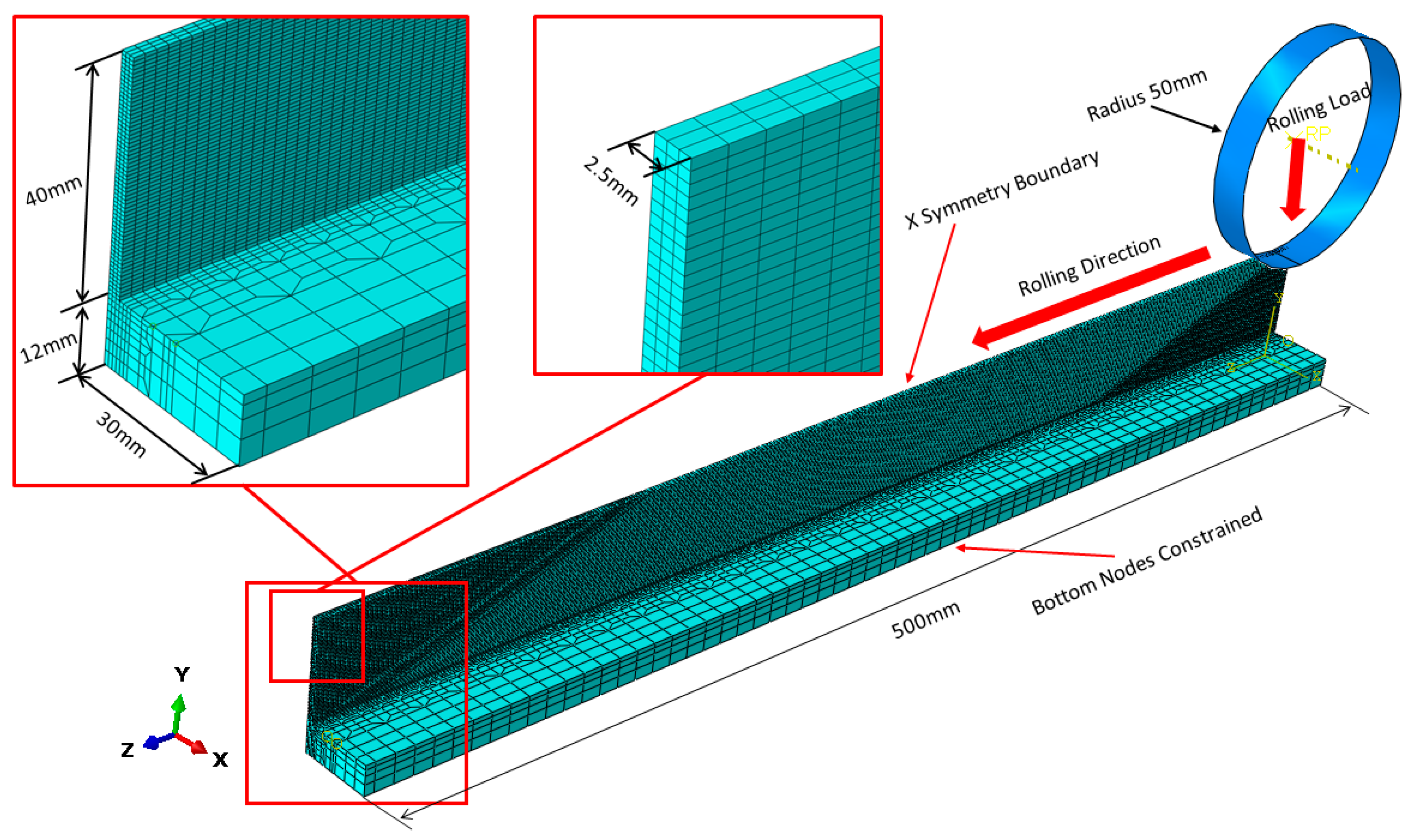
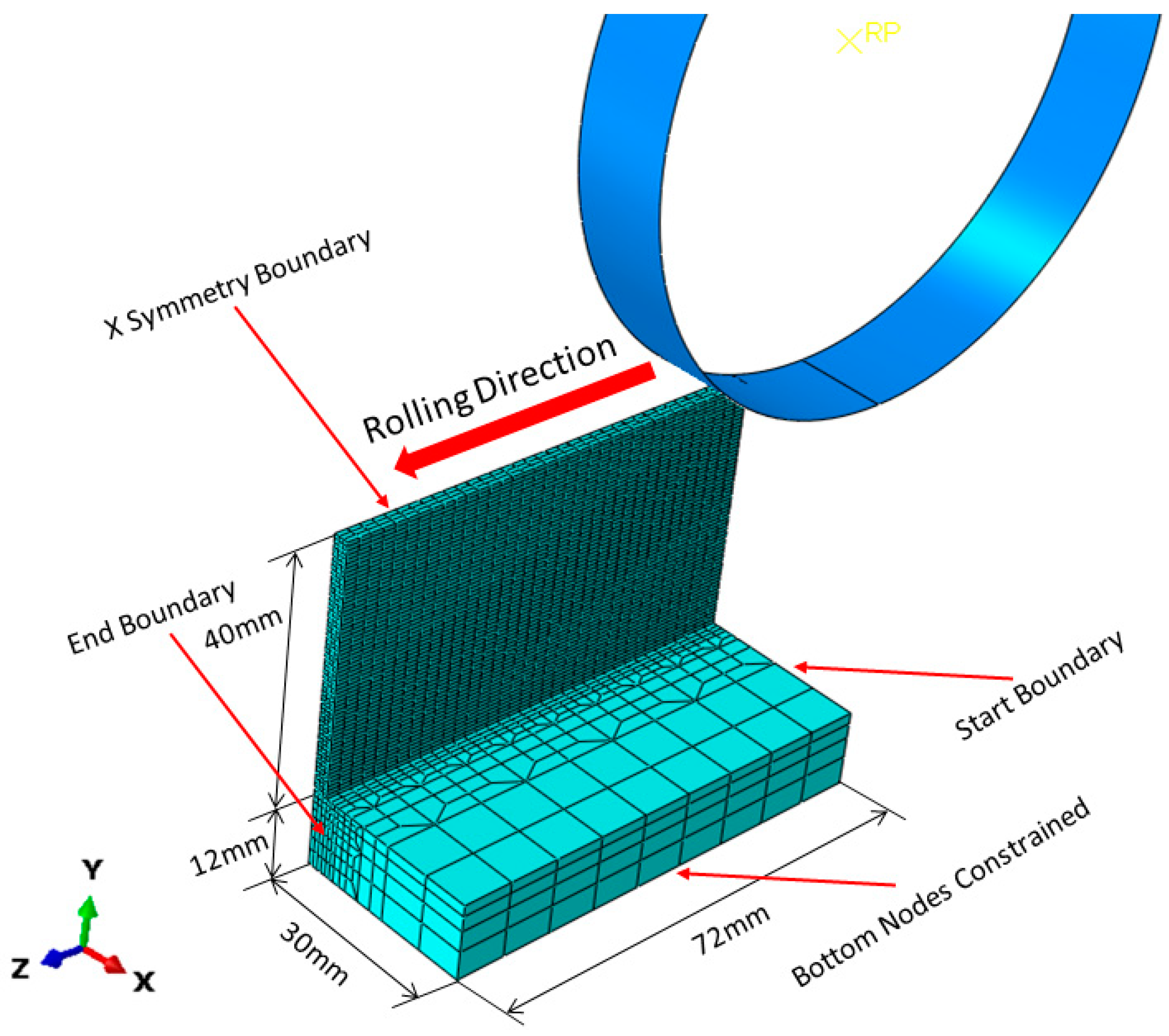
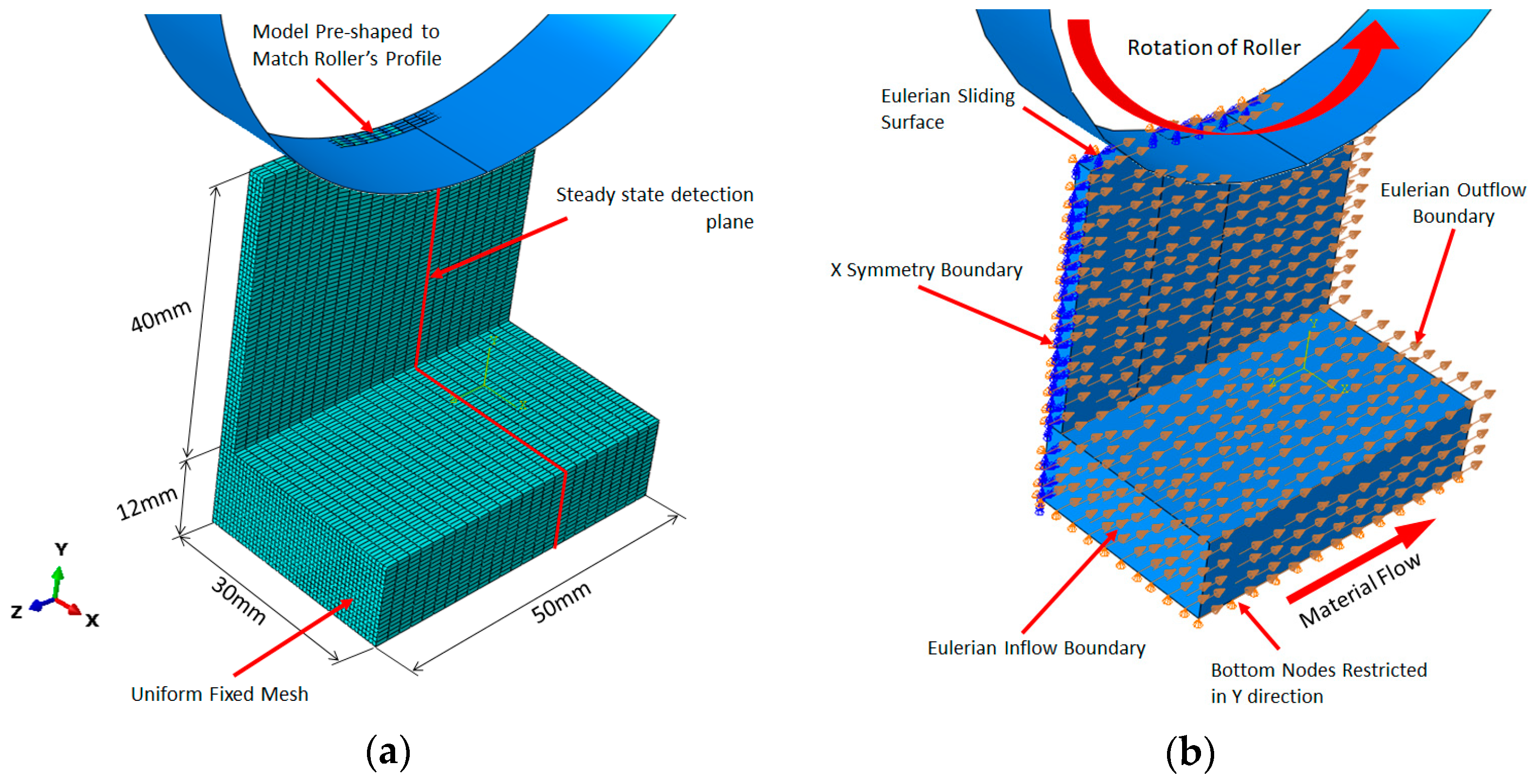

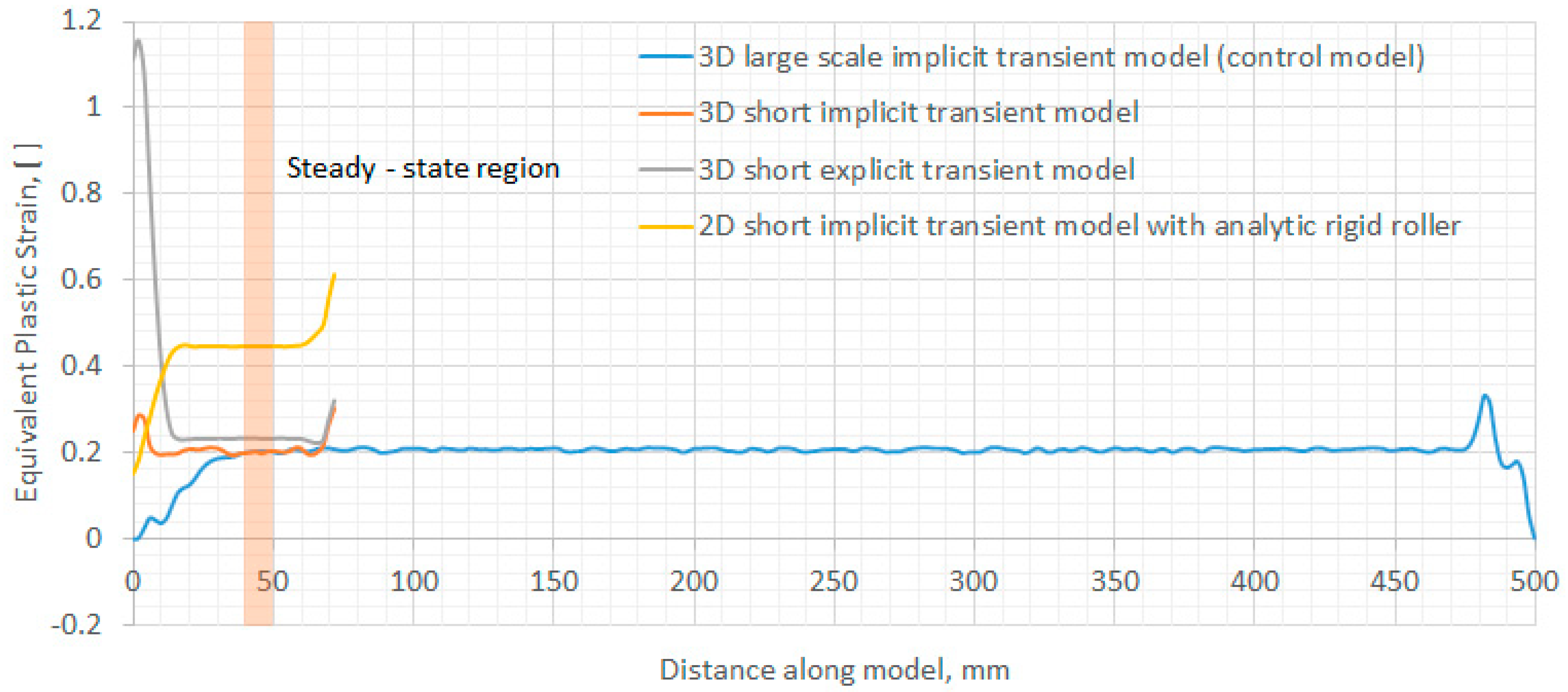

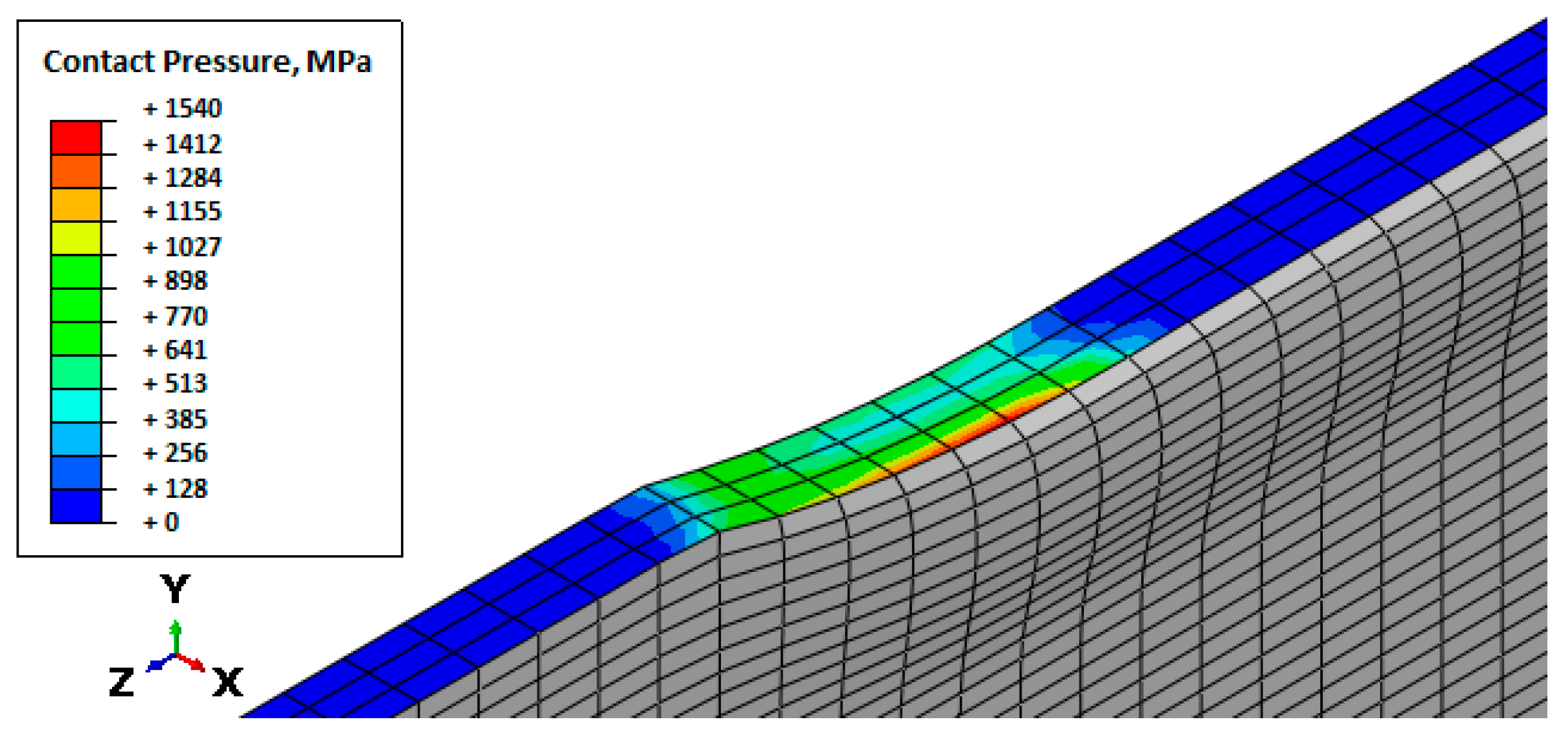


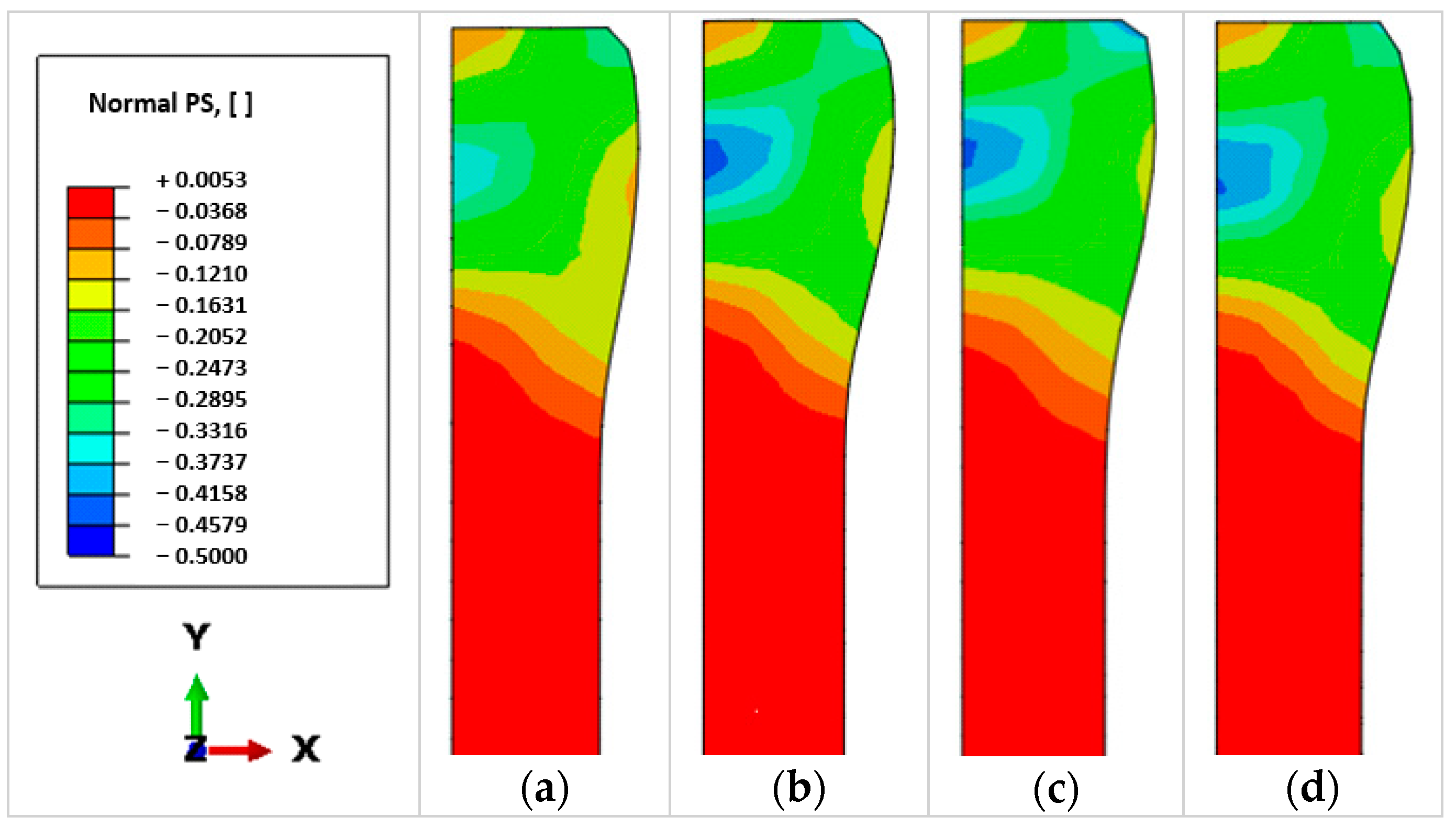



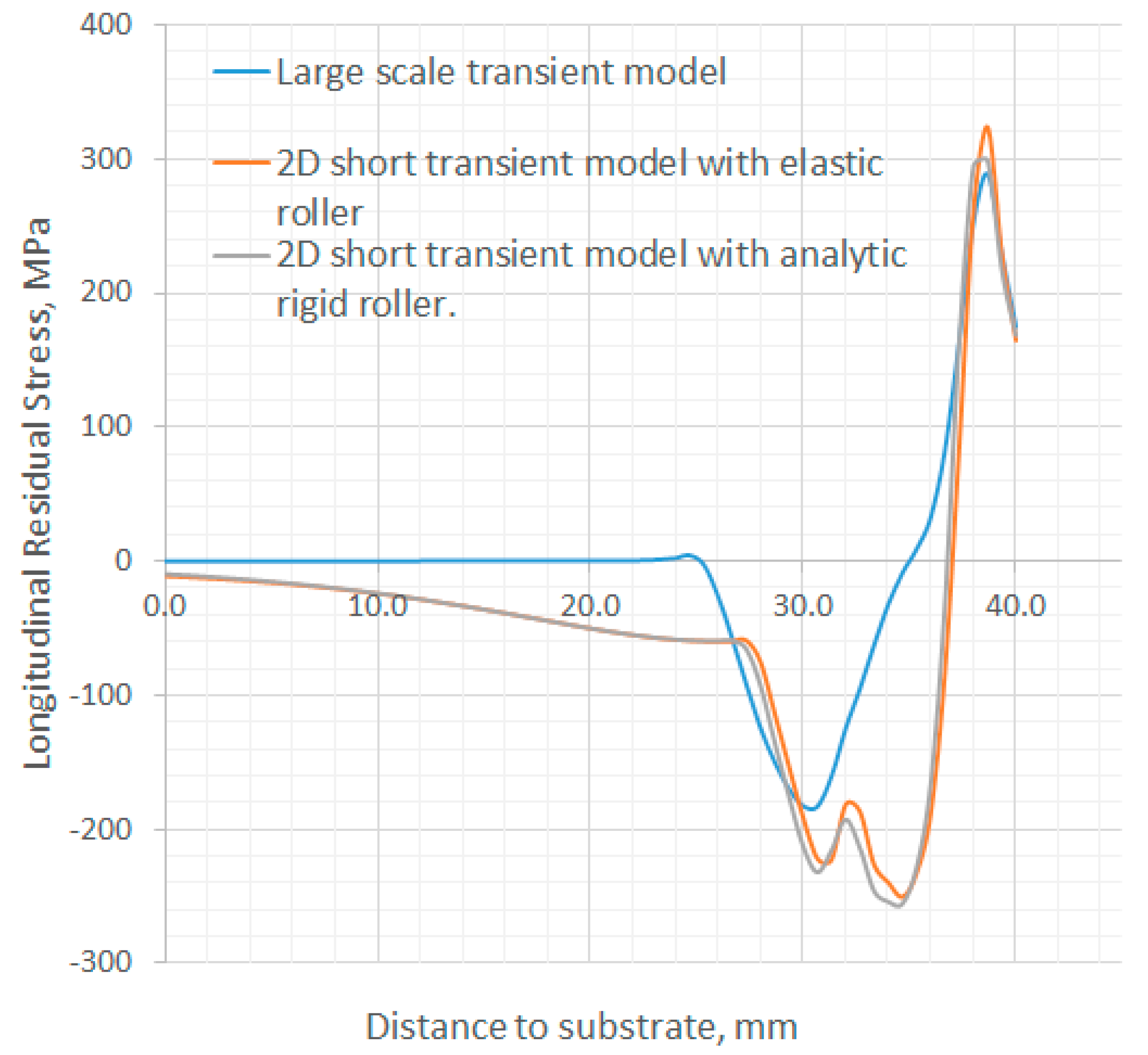

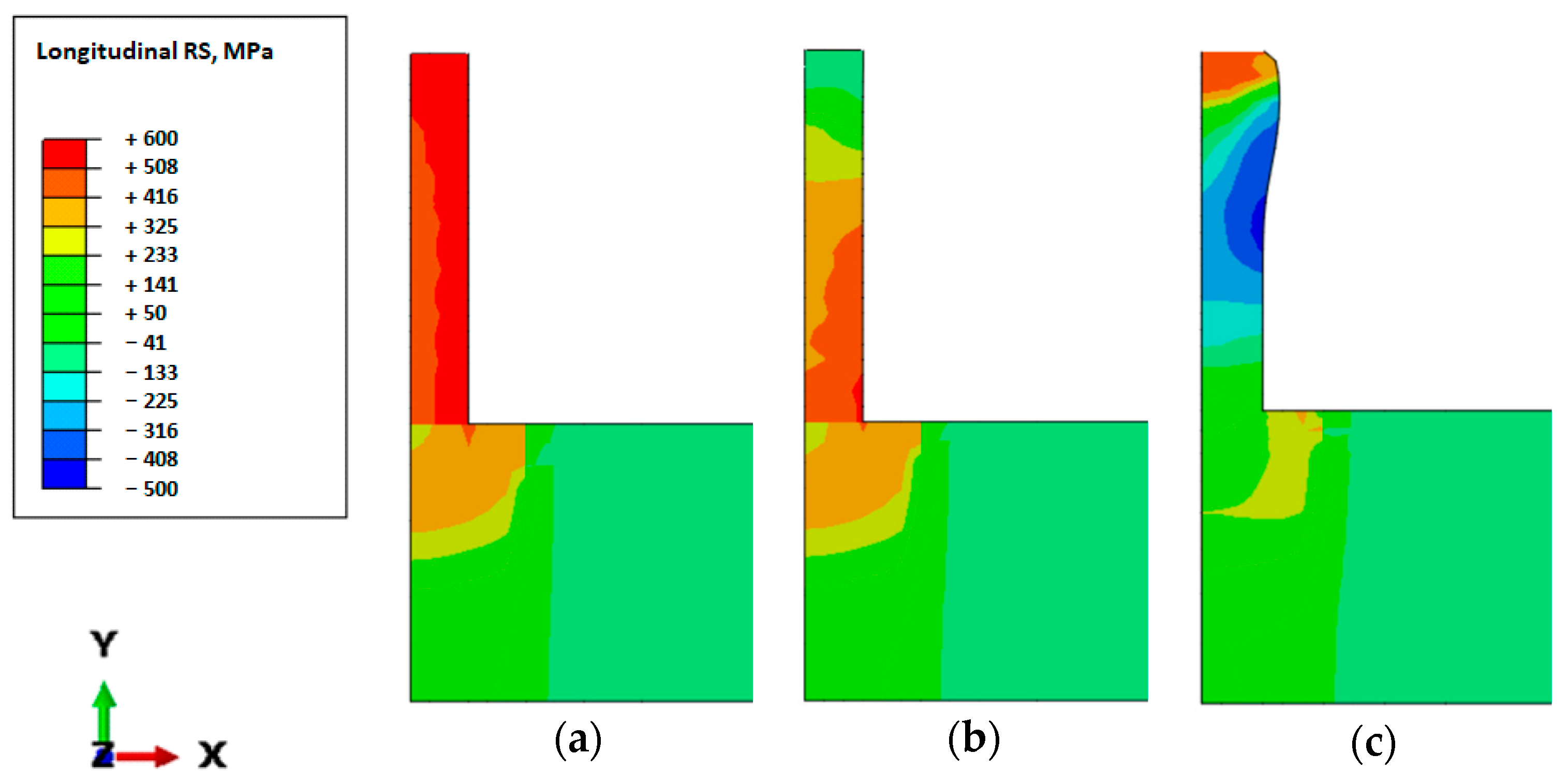
| Model | Number of Elements | Wall Clock Time with 4 CPUs Used (Seconds) | Total Time Saving, % |
|---|---|---|---|
| 3D large scale implicit transient model (control model) | 63,011 | 64,002 | N/A |
| 3D short implicit transient model | 9036 | 2238 | 96.50% |
| 3D short explicit transient model | 9036 | 2355 | 96.32% |
| 3D Eulerian steady-state model | 27,600 | 2613 # | 95.91% |
| 2D short implicit transient model with analytic rigid roller | 2516 | 302 | 99.52% |
| 2D short implicit transient model with elastic roller | 6284 | 588 | 99.08% |
Publisher’s Note: MDPI stays neutral with regard to jurisdictional claims in published maps and institutional affiliations. |
© 2021 by the authors. Licensee MDPI, Basel, Switzerland. This article is an open access article distributed under the terms and conditions of the Creative Commons Attribution (CC BY) license (http://creativecommons.org/licenses/by/4.0/).
Share and Cite
Gornyakov, V.; Sun, Y.; Ding, J.; Williams, S. Computationally Efficient Models of High Pressure Rolling for Wire Arc Additively Manufactured Components. Appl. Sci. 2021, 11, 402. https://doi.org/10.3390/app11010402
Gornyakov V, Sun Y, Ding J, Williams S. Computationally Efficient Models of High Pressure Rolling for Wire Arc Additively Manufactured Components. Applied Sciences. 2021; 11(1):402. https://doi.org/10.3390/app11010402
Chicago/Turabian StyleGornyakov, Valeriy, Yongle Sun, Jialuo Ding, and Stewart Williams. 2021. "Computationally Efficient Models of High Pressure Rolling for Wire Arc Additively Manufactured Components" Applied Sciences 11, no. 1: 402. https://doi.org/10.3390/app11010402
APA StyleGornyakov, V., Sun, Y., Ding, J., & Williams, S. (2021). Computationally Efficient Models of High Pressure Rolling for Wire Arc Additively Manufactured Components. Applied Sciences, 11(1), 402. https://doi.org/10.3390/app11010402






